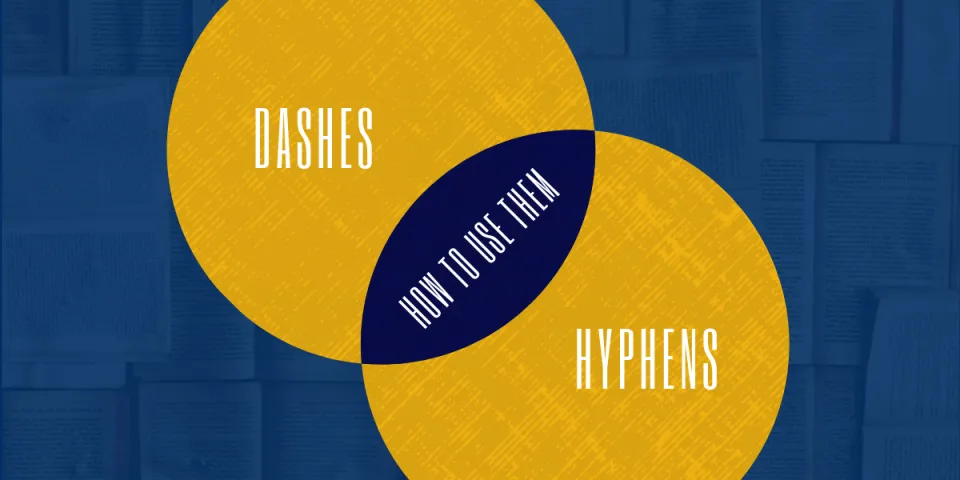Latest
Grammar Refresh: How to Use Dashes and Hyphens
Jun 20, 2019

Many students have trouble identifying the right time to use a dash or a hyphen. While the two look similar, they aren’t the same.
Let’s take a look at the different types of dashes you can use in your writing, and when and when not to use a hyphen.
What is an em-dash, and when should you use it?
An em-dash (also called a “long dash” or “thick dash”) is approximately the width of the letter “m,” which is where it earns its name. Here are some different situations when you can use an em-dash:
1. To add emphasis
Dashes are often used to signal an abrupt change in a sentence, indicating that the reader should pay close attention to what comes next. A dash can be used to add emphasis at the beginning, middle or end of a sentence. Here are some examples:
- As a working college student, time management is a very important skill – and one I’ve worked hard to improve.
- Continuing my education – even while balancing a full-time job and a young family – has been the best decision of my life.
While a comma can also be used to create emphasis, dashes signal a more dramatic or extended pause. It’s best to use dashes sparingly so that they have the intended effect on the reader.
2. To set off a series within a phrase
You can also use dashes to separate a series or a list in the middle of your sentence.
- There were so many different choices – blue, purple, yellow, orange – that I had a hard time picking just one color!
3. To add attribution
Use a dash to signal attribution at the end of a quote.
- “If you really look closely, most overnight successes took a long time." – Steve Jobs
Note: When typing em-dashes, always put a space before and after the dash.
When should you use a hyphen?
Hyphens are not the same as dashes. They are used to make a connection between two words working as a unit, or when two words have a combined meaning. These are known as compound words. Examples include “Mother-in-law” or “pick-me-up.” These words are always hyphenated, no matter where they fall in a sentence.
Here are some other types of compound words that require a hyphen:
1. Compound adjective
A compound adjective is used to modify a noun. In the following examples, the bolded words are part of a compound adjective that modifies the underlined noun.
- I have a ten-page paper due tonight.
- My 5-year-old son loves macaroni and cheese.
You do not need a hyphen if the adjective or descriptive phrase comes after the noun.
- My final paper is ten pages long.
- My son is 5 years old.
2. Compound words with participles
Compound modifiers with present or past participles (often ending in –ing or –ed) also require a hyphen.
- This record-breaking heat is killing me.
- Many companies are investing in wind-powered energy.
- I live in a densely-populated city.
3. Compound single-word verb
You should also use a hyphen when two nouns work together to form a verb. For example:
- Did you color-code these folders?
Some prefixes also require the use of a hyphen:
- I’m making a multi-layered cake.
- The self-checkout line is much faster.
- I was born in the mid-1990s.
- I had to re-read the entire chapter.
If you are not sure whether a hyphen is necessary, you can always consult your preferred dictionary.
And finally, what is an en-dash?
An en-dash (also called a “short dash”) is half the width of an em dash, approximately the width of the letter “n.”
In some writing stylebooks, such as The Chicago Manual of Style and The MLA Style Manual for academic writing, en-dashes are used to show ranges in numbers and dates. For example:
- She was in college from 2013 – 2017
In MLA style, en-dashes can also be used within institutional names, such as:
The AP Stylebook, used by most American newspapers as well as businesses and other institutions, does not recommend en-dashes.
Need to brush up on some other grammar basics? Check out our tips for using commas and semi-colons, or visit the Writing Center for one-on-one writing help!
Find Your Program At Herzing University
Bureau of Labor Statistics (BLS), U.S. Department of Labor, Occupational Employment and Wage Statistics 2023 / Occupational Outlook Handbook 2022. BLS estimates do not represent entry-level wages and/or salaries. Multiple factors, including prior experience, age, geography market in which you want to work and degree field, will affect career outcomes and earnings. Herzing neither represents that its graduates will earn the average salaries calculated by BLS for a particular job nor guarantees that graduation from its program will result in a job, promotion, salary increase or other career growth.
Latest
Recent Blog Posts
Subscribe to our Newsletter
Get the latest news you need to know, from study hacks to interview tips to career advancement. Have it delivered right to your inbox biweekly.








